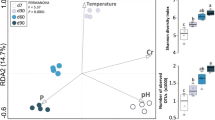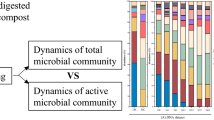Abstract
Organic matter degradation and bacterial communities associated to the thermophilic phase of composting were compared using two different types of anaerobic digestates, one from a sewage sludge digester (SD), and the other from an agricultural digester (AD). The composting process exhibited similar variations in temperature, pH, moisture content and bacterial profiles, despite the inherent feedstock differences along with distinctive initial bacterial composition. According to the data obtained from 16S rRNA gene amplicon sequencing, SD constituted more than 20 bacterial phyla with Proteobacteria (21%) and Chloroflexi (21%) being predominant, meanwhile AD was represented by only 7 phyla in which Firmicutes was the most abundant phylum (73%). Nevertheless, bacterial community profiles of the two composting systems became more similarly represented at the phylum level, both dominated by Proteobacteria (65% in AD and 61% in SD), whereas Chromatiaceae and Sphingomonadaceae were the most abundant families in AD and SD, respectively. Highly diverse but similar bacterial communities were detected during the composting of different anaerobic digestates at the thermophilic phase.
Graphical Abstract





Similar content being viewed by others
References
Banegas, V., Moreno, J.L., Moreno, J.I., García, C., León, G., Hernández, T.: Composting anaerobic and aerobic sewage sludges using two proportions of sawdust. Waste Manag. 27, 1317–1327 (2007). https://doi.org/10.1016/j.wasman.2006.09.008
Liu, D., Zhang, R., Wu, H., Xu, D., Tang, Z., Yu, G., Xu, Z., Shen, Q.: Changes in biochemical and microbiological parameters during the period of rapid composting of dairy manure with rice chaff. Bioresour. Technol. 102, 9040–9049 (2011). https://doi.org/10.1016/j.biortech.2011.07.052
Ince, O., Ozbayram, E.G., Akyol, Ç, Ince, O., Ince, B.: Composting practice for sustainable waste management: a case study in Istanbul. Desalin. Water Treat. 57, 14473–14477 (2016). https://doi.org/10.1080/19443994.2015.1067170
Nakasaki, K., Tran, L.T.H., Idemoto, Y., Abe, M., Rollon, A.P.: Comparison of organic matter degradation and microbial community during thermophilic composting of two different types of anaerobic sludge. Bioresour. Technol. 100, 676–682 (2009). https://doi.org/10.1016/j.biortech.2008.07.046
Wang, K., Mao, H., Li, X.: Functional characteristics and influence factors of microbial community in sewage sludge composting with inorganic bulking agent. Bioresour. Technol. 249, 527–535 (2018). https://doi.org/10.1016/j.biortech.2017.10.034
Grigatti, M., Cavani, L., Marzadori, C., Ciavatta, C.: Recycling of dry-batch digestate as amendment: soil C and N dynamics and ryegrass nitrogen utilization efficiency. Waste Biomass Valoriz. 5, 823–833 (2014). https://doi.org/10.1007/s12649-014-9302-y
Franke-Whittle, I.H., Confalonieri, A., Insam, H., Schlegelmilch, M., Körner, I.: Changes in the microbial communities during co-composting of digestates. Waste Manag. 34, 632–641 (2014). https://doi.org/10.1016/j.wasman.2013.12.009
Wu, C., Li, W., Wang, K., Li, Y.: Usage of pumice as bulking agent in sewage sludge composting. Bioresour. Technol. 190, 516–521 (2015). https://doi.org/10.1016/j.biortech.2015.03.104
Feng, L., Luo, J., Chen, Y.: Dilemma of sewage sludge treatment and disposal in China. Environ. Sci. Technol. 49, 4781–4782 (2015). https://doi.org/10.1021/acs.est.5b01455
Zhang, D., Luo, W., Li, Y., Wang, G., Li, G.: Performance of co-composting sewage sludge and organic fraction of municipal solid waste at different proportions. Bioresour. Technol. 250, 853–859 (2018). https://doi.org/10.1016/j.biortech.2017.08.136
Villar, I., Alves, D., Garrido, J., Mato, S.: Evolution of microbial dynamics during the maturation phase of the composting of different types of waste. Waste Manag. 54, 83–92 (2016). https://doi.org/10.1016/j.wasman.2016.05.011
Xu, J., Lu, Y., Shan, G., Song, X., Huang, J., Li, Q.: Inoculation with compost-born thermophilic complex microbial consortium induced organic matters degradation while reduced nitrogen loss during co-composting of dairy manure and sugarcane leaves. Waste Biomass Valoriz. (2018). https://doi.org/10.1007/s12649-018-0293-y
López-González, J.A., Vargas-García, MdelC., López, M.J., Suárez-Estrella, F., Jurado, MdelM., Moreno, J.: Biodiversity and succession of mycobiota associated to agricultural lignocellulosic waste-based composting. Bioresour. Technol. 187, 305–313 (2015). https://doi.org/10.1016/j.biortech.2015.03.124
Sundberg, C., Al-Soud, W.A., Larsson, M., Alm, E., Yekta, S.S., Svensson, B.H., Sørensen, S.J., Karlsson, A.: 454 pyrosequencing analyses of bacterial and archaeal richness in 21 full-scale biogas digesters. FEMS Microbiol. Ecol. 85, 612–626 (2013). https://doi.org/10.1111/1574-6941.12148
Green, S.J., Michel, F.C., Hadar, Y., Minz, D.: Similarity of bacterial communities in sawdust- and straw-amended cow manure composts. FEMS Microbiol. Lett. 233, 115–123 (2004). https://doi.org/10.1016/j.femsle.2004.01.049
Karadag, D., Özkaya, B., Ölmez, E., Nissilä, M.E., Çakmakçi, M., Yildiz, Ş, Puhakka, J.A.: Profiling of bacterial community in a full-scale aerobic composting plant. Int. Biodeterior. Biodegrad. 77, 85–90 (2013). https://doi.org/10.1016/j.ibiod.2012.10.011
Tian, W., Sun, Q., Xu, D., Zhang, Z., Chen, D., Li, C., Shen, Q., Shen, B.: Succession of bacterial communities during composting process as detected by 16S rRNA clone libraries analysis. Int. Biodeterior. Biodegrad. 78, 58–66 (2013). https://doi.org/10.1016/j.ibiod.2012.12.008
Wang, X., Cui, H., Shi, J., Zhao, X., Zhao, Y., Wei, Z.: Bioresource technology relationship between bacterial diversity and environmental parameters during composting of different raw materials. Bioresour. Technol. 198, 395–402 (2015). https://doi.org/10.1016/j.biortech.2015.09.041
de Gannes, V., Eudoxie, G., Hickey, W.J.: Prokaryotic successions and diversity in composts as revealed by 454-pyrosequencing. Bioresour. Technol. 133, 573–580 (2013). https://doi.org/10.1016/j.biortech.2013.01.138
Zhang, L., Zhang, H., Wang, Z., Chen, G., Wang, L.: Dynamic changes of the dominant functioning microbial community in the compost of a 90-m3aerobic solid state fermentor revealed by integrated meta-omics. Bioresour. Technol. 203, 1–10 (2016). https://doi.org/10.1016/j.biortech.2015.12.040
Wang, C., Dong, D., Wang, H., Müller, K., Qin, Y., Wang, H., Wu, W.: Metagenomic analysis of microbial consortia enriched from compost: new insights into the role of Actinobacteria in lignocellulose decomposition. Biotechnol. Biofuels. 9, 1–17 (2016). https://doi.org/10.1186/s13068-016-0440-2
APHA/AWWA/WEF: Standard Methods for the Examination of Water and Wastewater. Stand. Methods. 541 (2012). ISBN 9780875532356
Ondov, B.D., Bergman, N.H., Phillippy, A.M.: Interactive metagenomic visualization in a Web browser. BMC Bioinform. 12, 385 (2011). https://doi.org/10.1186/1471-2105-12-385
Liang, B., Wang, L.Y., Mbadinga, S.M., Liu, J.F., Yang, S.Z., Gu, J.D., Mu, B.Z.: Anaerolineaceae and Methanosaeta turned to be the dominant microorganisms in alkanes-dependent methanogenic culture after long-term of incubation. AMB Express 5, 37 (2015). https://doi.org/10.1186/s13568-015-0117-4
Sträuber, H., Lucas, R., Kleinsteuber, S.: Metabolic and microbial community dynamics during the anaerobic digestion of maize silage in a two-phase process. Appl. Microbiol. Biotechnol. 100, 479–491 (2016). https://doi.org/10.1007/s00253-015-6996-0
Oren, A.: The order Halanaerobiales, and the families Halanaerobiaceae and Halobacteroidaceae. In: The Prokaryotes, pp. 153–177. Springer, Berlin (2014)
Ozbayram, E.G., Kleinsteuber, S., Nikolausz, M., Ince, B., Ince, O.: Enrichment of lignocellulose-degrading microbial communities from natural and engineered methanogenic environments. Appl. Microbiol. Biotechnol. 102, 1035–1043 (2018). https://doi.org/10.1007/s00253-017-8632-7
Vargas-García, M.C., Suárez-Estrella, F., López, M.J., Moreno, J.: Microbial population dynamics and enzyme activities in composting processes with different starting materials. Waste Manag. 30, 771–778 (2010). https://doi.org/10.1016/j.wasman.2009.12.019
Wang, L., Wang, L., Wang, D., Li, J.: Isolation and application of thermophilic and psychrophilic microorganisms in the composting process. Waste Biomass Valoriz. 5, 433–440 (2014). https://doi.org/10.1007/s12649-013-9253-8
Bustamante, M.A., Restrepo, A.P., Alburquerque, J.A., Pérez-Murcia, M.D., Paredes, C., Moral, R., Bernal, M.P.: Recycling of anaerobic digestates by composting: effect of the bulking agent used. J. Clean. Prod. 47, 61–69 (2013). https://doi.org/10.1016/j.jclepro.2012.07.018
Chroni, C., Kyriacou, A., Manios, T., Lasaridi, K.E.: Investigation of the microbial community structure and activity as indicators of compost stability and composting process evolution. Bioresour. Technol. 100, 3745–3750 (2009). https://doi.org/10.1016/j.biortech.2008.12.016
Imhoff, J.: The Chromatiaceae. The prokaryotes. pp. 846–873. Springer, New York (2006). https://doi.org/10.1007/0-387-30746-x_31
López-González, J.A., Suárez-Estrella, F., Vargas-García, M.C., López, M.J., Jurado, M.M., Moreno, J.: Dynamics of bacterial microbiota during lignocellulosic waste composting: studies upon its structure, functionality and biodiversity. Bioresour. Technol. 175, 406–416 (2015). https://doi.org/10.1016/j.biortech.2014.10.123
Manz, W., Amann, R., Ludwig, W., Vancanneyt, M., Schleifer, K.H.: Application of a suite of 16S rRNA-specific oligonucleotide probes designed to investigate bacteria of the phylum cytophaga-flavobacter-bacteroides in the natural environment. Microbiology. 142, 1097–1106 (1996). https://doi.org/10.1099/13500872-142-5-1097
Willems, A.: The family Comamonadaceae. In: The Prokaryotes, pp. 777–851. Springer, Berlin (2014)
Mandic-Mulec, I., Stefanic, P., van Elsas, J.D.: Ecology of Bacillaceae. In: The bacterial spore: from molecules to systems, pp. 59–85. American Society of Microbiology, Atlanta (2015)
Carareto Alves, L.M., de Souza, J.A.M., Varani, A., de Mello, L.: The family Rhizobiaceae. In: The Prokaryotes, pp. 419–437. Springer, Berlin (2014)
Austin, B.: The family Alcaligenaceae. In: The Prokaryotes, pp. 729–757. Springer, Berlin (2014)
Zhao, H.Y., Li, J., Liu, J.J., Lü, Y.C., Wang, X.F., Cui, Z.J.: Microbial community dynamics during biogas slurry and cow manure compost. J. Integr. Agric. 12, 1087–1097 (2013). https://doi.org/10.1016/S2095-3119(13)60488-8
Acknowledgements
This study was supported by The Scientific and Technological Research Council of Turkey (TUBITAK Project No. 113Y451).
Author information
Authors and Affiliations
Corresponding author
Ethics declarations
Conflict of interest
The authors declare that there are no conflicts of interest.
Additional information
Publisher’s Note
Springer Nature remains neutral with regard to jurisdictional claims in published maps and institutional affiliations.
Rights and permissions
About this article
Cite this article
Ince, O., Ozbayram, E.G., Akyol, Ç. et al. Bacterial Succession in the Thermophilic Phase of Composting of Anaerobic Digestates. Waste Biomass Valor 11, 841–849 (2020). https://doi.org/10.1007/s12649-018-0531-3
Received:
Accepted:
Published:
Issue Date:
DOI: https://doi.org/10.1007/s12649-018-0531-3




